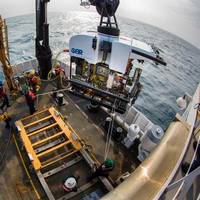NOAA to Explore Depths of Caribbean Sea

Public can watch seafloor discoveries live online April 9-30. Beginning April 9, scientists aboard NOAA Ship Okeanos Explorer will begin a series of 20 dives to investigate previously unseen depths of the Caribbean Sea and Atlantic Ocean – and the public can follow along online. During dives that are expected to go as deep as 3.7 miles, a sophisticated unmanned submarine, called a remotely operated vehicle, or ROV, will broadcast live video from the seafloor, allowing anyone with Internet access to watch the expedition as it unfolds.
Coast Guard Asks Mariners to Maintain Safe Distance from Marine Mammals
With more than 10,000 humpback whales migrating to the Hawaiian Islands this year, crews from the Coast Guard, National Oceanic and Atmospheric Administration, and the State of Hawaii's Division of Conservation and Resource Enforcement, from the Department of Land and Natural Resources are partnering together to protect humpback whales. Humpback whale season is generally from November to May with the peak season occurring during the months of January and March. According to the Hawaiian Islands Humpback Whale National Marine Sanctuary, whales come to the Hawaiian Islands to mate, calve, and nurse their young. They return to Alaska in the summer months because Hawaii's waters are relatively nutrient-free and too warm to support enough of the humpback's food to sustain them year-round.
NOAA Seeks Comments On USN Sonar Deployment
NOAA's National Marine Fisheries Service is seeking public comment on a request by the U.S. Navy to operate its Low Frequency Active Sonar on the world's open oceans. The Navy's Surveillance Towed Array Sensor System Low Frequency Active Sonar uses an underwater sound source to locate submarines, and the agency wants to ensure the operation of the system has a negligible impact on marine mammals. Unique to this proposal, NOAA Fisheries and the Navy are proposing to establish "Offshore Biologically Important Areas (OBIAs)" in which the SURTASS LFA sonar ships would not operate. OBIAs are areas of the world's oceans where marine mammals congregate in high numbers to feed, migrate, breed and calve. To date, the U.S.





